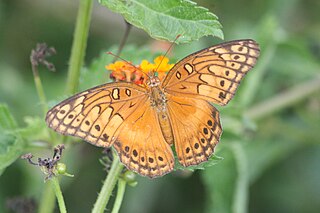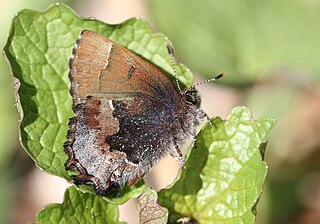
The common blue butterfly or European common blue is a butterfly in the family Lycaenidae and subfamily Polyommatinae. The butterfly is found throughout the Palearctic and has been introduced to North America. Butterflies in the Polyommatinae are collectively called blues, from the coloring of the wings. Common blue males usually have wings that are blue above with a black-brown border and a white fringe. The females are usually brown above with a blue dusting and orange spots.

Anthocharis midea, the falcate orangetip, is a North American butterfly that was described in 1809 by Jacob Hübner. It belongs to the family Pieridae, which is the white and sulphurs. These butterflies are mostly seen in the eastern United States, and in Texas and Oklahoma. They eat the nectar of violets and mustards. They tend to live in open, wet woods along waterways, in open swamps, and less often in dry woods and ridgetops. This species is a true springtime butterfly, being on the wing from April to May.

Eurytides marcellus, the zebra swallowtail, is a swallowtail butterfly native to the eastern United States and south-eastern Canada. It is the state butterfly of Tennessee. Its distinctive wing shape and long tails make it easy to identify, and its black-and-white-striped pattern is reminiscent of a zebra. The butterflies are closely associated with pawpaws, and are rarely found far from these trees. The green or black caterpillars feed on the leaves of various pawpaw species, while the adults feed on flower nectar and minerals from damp soil.

The green hairstreak is a small butterfly in the family Lycaenidae.

The purple hairstreak is a butterfly in the family Lycaenidae distributed throughout much of Europe, North Africa, Anatolia, Caucasia, and Transcaucasia. The larva feeds on Quercus robur, Quercus petraea, Quercus cerris and Quercus ilex.

The Zabulon skipper is a North American butterfly first described by the French naturalists Jean Baptiste Boisduval and John Eatton Le Conte from the state of Georgia, United States.

Eurema nicippe, the sleepy orange, is a North American butterfly in the family Pieridae. Its range spans from Central America to north along the United States-Mexico border, and it often travels further to non-mountainous regions of the southeastern United States.

Nathalis iole, the dainty sulphur or dwarf yellow, is a North American butterfly in the family Pieridae.

Euptoieta claudia, the variegated fritillary, is a North and South American butterfly in the family Nymphalidae. Even though the variegated fritillary has some very different characteristics from the Speyeria fritillaries, it is still closely related to them. Some of the differences are: variegated fritillaries have two or three broods per year vs. one per year in Speyeria; they are nomadic vs. sedentary; and they use a wide range of host plants vs. just violets. And because of their use of passionflowers as a host plant, variegated fritillaries also have taxonomic links to the heliconians. Their flight is low and swift, but even when resting or nectaring, this species is extremely difficult to approach, and, because of this, its genus name was taken from the Greek word euptoietos meaning "easily scared".

Euptoieta hegesia, the Mexican fritillary, is a North and South American butterfly in the family Nymphalidae.

Telegonus cellus, the golden banded-skipper, is a North and Central American species of butterfly in the family Hesperiidae. There are two populations, one in the eastern United States and the other in the southwestern United States and Mexico. The eastern population is rare and local and uses only one host plant, the thicket bean. The southwestern population is uncommon to common and uses more than one host plant. The golden banded-skipper is most active mid-morning and late afternoon. Their flight is sluggish and low to the ground, compared to closely related species.

Ancyloxypha numitor, the least skipper, is a North American butterfly in the family Hesperiidae. They have a weak, Satyrinae-like flight.

Thorybes bathyllus, the southern cloudywing, is a North American butterfly in the family Hesperiidae. Southern cloudywings can be difficult to identify because of individual variation and confusing seasonal forms. In the south, where it has two broods per year, two seasonal forms occur. Spring forms are usually lightly marked and resemble confused cloudywings. Summer forms tend to be more boldly marked, by comparison, making identification easier. However, summer confused cloudywings are also strongly patterned, which makes identifying them more difficult. Their rapid flight is very erratic, though it is closer to the ground than in some of its close relatives.

Polites themistocles, the tawny-edged skipper, is a North American butterfly in the family Hesperiidae.

Lycaena epixanthe, also known as the bog copper or cranberry-bog copper, is a North American species of butterfly in the family Lycaenidae. Adults like to sip drops of dew clinging to leaves and almost exclusively nectar on their host plant, cranberries. Because of this, bog coppers will spend their entire lives within the area of a single acid bog. Even though their flight is weak and close to the ground, bog coppers are hard to catch because of the habitat in which they live. Also, 85% of the bog coppers life span is spent in the egg. It is listed as a species of special concern in the US state of Connecticut.

Danaus eresimus, the soldier or tropical queen, is a North American, Caribbean, and South American butterfly in the family Nymphalidae.

Papilio brevicauda, the short-tailed swallowtail, is a North American butterfly in the family Papilionidae.

Chlosyne lacinia, the bordered patch or sunflower patch, is a North and South American butterfly in the family Nymphalidae.

Callophrys henrici, the Henry's elfin or woodland elfin, is a North American butterfly in the family Lycaenidae. In Canada it is found from southern Manitoba to southern Nova Scotia. It has two main groups of populations in the United States; the first is found along the Atlantic Coast and uses various hollies (Ilex) as host plants; and the second is found mainly in the north and the Appalachians where they use redbud as a host plant. Henry's elfin is increasing in New England because of an introduced buckthorn it now uses as a host plant. It is listed as a species of special concern in the US state of Connecticut.

Papilio palamedes, the Palamedes swallowtail or laurel swallowtail, is a North American butterfly in the family Papilionidae.





















